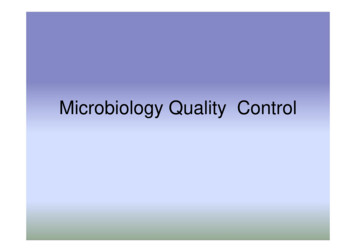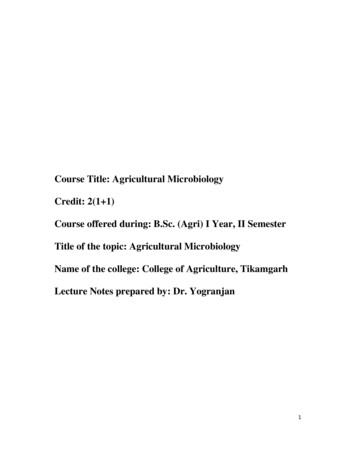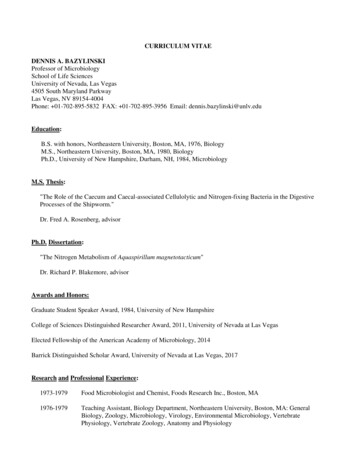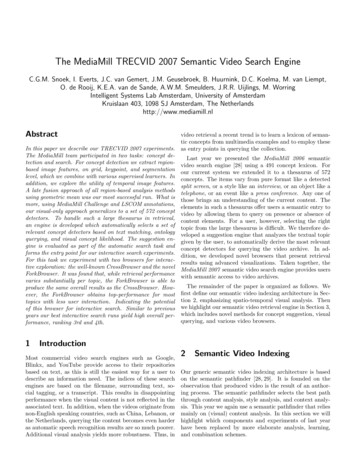
Transcription
Microbiology Quality Control
Quality Systems in the Clinical Lab. Quality Assurance (QA)Quality Control(QC)Quality Improvement(QI)
Quality Control ? Continual monitoring of working practices,equipment & reagents so as to detecting &correcting defects Maintains reliable / timely analytical performance (result / outcome) More patient-care-oriented approach
Stages of laboratory activities The QC program must ensure optimumpatient specimens and result integritythroughout the 3 stages processes: 1. Pre-analytical 2. Analytical 3. Post-analytical
Three stages of activitiesTable 1- Three stages of activities that affect outcome of laboratory testing:StagePreanalyticalActivitiesTest orderingOrder transcriptionPatient preparationSpecimen collectionSpecimen identificationSpecimen transportAnalyticalSample testing (ID & ST)Post-analyticalResult transcriptionResult intrepretationAction taken on basis of resultA quality outcome can be interrupted or destroyed at any point in the process.
Fishbone diagramdisplay important components of a processReportSpecimen prepauthorizedPhone callSpecimen transportDiagnosisResult intrepretationSpecimen processingClinical assessment
Fishbone diagram Examination of a process fromfishbone diagram help showpotential weaknesses and revealhow improvements in the processmight be achieved
Quality indicators Data elements that discriminate between asystem that is operating & one that is flawed Examples Sputum: appropriate collection»If specimens with more than 25epithelial cell Low Power Field Urine: appropriate collection–If No. of cultures with mixed ( / 3)organisms
Quality Control Program Quality of the specimenProcedure manualPersonnelMediaInstrumentsReagentQuality assessment-Internal audit-Profeciency testing/external quality assessment
Quality of the me/clinical result Health care value of the information providedby clinical microbiology lab is beingsignificantly compromised by inappropriatespecimens
Quality of the specimen Inappropriate specimens:––––Submission of contaminated specimensDelay in specimen deliveryViral culture without transport mediaCollection of specimens from inappropriate body sites Collection of microbiology specimens isgenerally not under direct control of lab.
Quality of the specimen Specify specimens rejection criteria eg.specimen container leaking, Specimen in wrongmedium, Non-sterile container for culture put-up or reception bench should strictly followthese criteria Monitoring the specific nursing unit & education,training to improve collection or transportprocedures In case any doubt, consult microbiologist
Procedure manual Must contain all test methods performed bythe laboratory e.g. 2 specific format:– College of American Pathologists (CAP)– Clinical Laboratory Improvement Act 88 (CLIA88)
Procedure manualCLIA 88CAP16-item formatNCCLS publication GP2-course of action to be taken inthe event that a test systembecomes inoperable-criteria for proper collection,preservation, & transportation ofspecimensManufacturer’s product insert orprocedure manual is acceptable ifit includes all of the required CLIA88 itemsPackage inserts are notacceptable to CAP, but amanufacturer’s instrumentmanual that complies withNCCLS publication GP2 isacceptable
College of American Pathologists (CAP)-should be available to, and used by personnel at the workbenchPrincipleClinical significanceSpecimen typeRequired reagentsCalibrationQuality controlProcedural stepsCalculationsReference rangesInterpretation (usage of result or indication of result)
Procedure manual The director must ensure that thecollection of policies and technicalprotocols is complete, current & hasbeen thoroughly reviewed by aknowledgeable person
Personnel Active participation by everyone working inthe system is required to meet qualitystandards & continuously improveperformance Assign responsibility / duties
PersonnelPersonnelFunction-Reviews and approves policies and procedures required toQualityachieve quality improvement goalsImprove ment- Fosters interdisciplinary communication, facilitatesExecutiveCommitteeproblem solving and documents results of QA activities.-Participates in monitoring and evaluating laboratoryservices. Provides recommendations for improvingMicrobiolog- services; for example; The microbiologist must make manyistclinical decisions regarding collection and transmission ofspecimens. The extent of his/her role in the interpretationand utilization of microbiological information must also beconsideredImplements procedures and manages data in accordanceTechnologists with QA goals. Provides recommendations to director for& Technicianimproving services
Personnel The employee’s personnel recordscontain:– Qualification & experience– The tasks & procedures that the employee isauthorized to perform (dates of receivedtraining & competence tests)– Continuing education activities (attend sometraining program or workshop)– Regular meeting to keep staff informed ofchanges & to solicit their suggestion forimproving the lab. service
Media Poor quality control (QC) of preparedmedia can adversely affect theperformance media produced in a microbiologydepartment are performing to anacceptable standard, allowing optimumgrowth of specific organisms
Media The test program is based on the following basicparameters to be examined & recorded Physical characteristics: Microbiological performancecolourclaritypH (test the pH with pH electrode)sterility (incubate for 24-48 hr at RT & 37 C)gel strength (test freshly poured & surface-dried plate witha wire loop, not too soft and hard)
Media Physical characteristicsDateMedium Lot Colour Clarity GelpHsterilitySign#2/5/02ChoX OkOkOk Ok okJoMAC xx OkOkOk Ok okJo
Media Microbiological performance-(CLSI)-Nutrient medium (bl , cho) must be tested the growth ofone or two organisms-Selective media should be tested with organisms whichwould be expected to grow and those organismsexpected not to grow-Test strains: American Type Culture Collection (ATCC) # selected as critical for each medium & suitable indicatorsfor routine monitoring of performance
Media Labeling:Date of preparationMediaLot No.Expiration DateQCStorage conditionTechnologist
Instruments Specimen egProcessingInstrumentsResultchecking the percentage of CO2 in an incubatorchecking the anaerobic chamberchecking temperature-dependent equipment suchas heating blocks, water baths, refrigerators &freezers How?
Instruments Daily checking & record the data (chart) Daily & monthly maintenance programmust be established A preventive maintenance program mustbe established as an additional controlmeasureeg:oiling & cleaning, replacing filters etc.
Frequency of maintenance? equipment is cleared orapproved by (FDA) follow the frequencyof maintenance & function checkspecified by the manufacturerFDA: Food and Drug AdministrationnotIn-houseschedule
Reagents Daily- Reagents should be tested each day ofuse with both positive & negativecontrols- in-use reagent vial is refrigerated at nightbut usually left at room temperature duringthe day & therefore has the opportunity todegrade while in use
Reagents Weekly-reagents that are documented to haveconsistent & dependable results may betested less frequently-eg. Gram stain, is commonly tested weeklyinstead of daily
Reagents-examples undergo QC All eOptochin
Internal audit Aim: Monitoring the performance of the whole procedures Method:Laboratory activities (pre-analytic analytic & post-analytic)were examined Standards were set using laboratory standard operatingprocedures The findings were discussed the measured performance was reviewed an explanation for any deficiencies sought
Internal auditSuboptimal performance/ any deficienciesLaboratory methodsUrgent reviewHuman errorenchance checking
Profeciency testing/ quality assessment Profeciency testing/quality assessment InternallyExternallyspecimens of known contentare introduced into the routinesystem by senior staff whoreceive & evaluate the reportsspecimens of known contentare sent to laboratory for EX.& the result are reported toorganizing lab. & evaluatedeg MMUnited Kingdom National ExternalQuality AssessmentScheme(UKNEQAS)
Profeciency testing/ quality assessment Both scheme act as an indicator of theeffectiveness of internal quality control program Advantage of external quality assessment1/ provision of wide variety of organisms2/ stable specimens3/ chance to compare individual performance withother participants
How to set up a good QualityControl Program in MedicalMicrobiology Laboratory
QA:Q ua li ty a s s ura nceS ys te m fo r im p ro v in gR e liab ilit yE ffic ie nc yU t iliza t io n o f p ro d u uc ts & ser v icesIn c lin ica l m ic ro b io lo g y, Q A mo n ito r t he p er fo r m a nce o f eq u ip me n t a nd rea g e nts toexa m in e t he c lin ica l va lu e o f se r v ice s a nd in fo r ma t io nP ro cess :P ro fic ie nc y w it hw h ic h t he w o rkp er fo r m edS tr uct u read eq uac y o f t he w o rk p lace& t he p ro v is io ns req u ired tod o t he jo bO ut co meco nseq ue nc es o f w o rkp er fo r med
Media-antimicrobial susceptibility QC Specific strains of Haemophilus influenzae &Nesisseria gonorrhoeae Variables to control that can affect the accuracy of results1 antibiotic potency2 agar depth (Kirby-Bauer test)3 pH4 inoculum5 incubation time & temperature6 moisture7 CO2 concentration
Quality management system
3G Good laboratory practice (GLP) Good quality assurance Good communication
Good laboratory practicesThree phases of testing: 1) before testing (test ordering andspecimen collection), 2) during testing (control testing, testperformance, and result interpretation andrecording), and 3) after testing (result reporting,documentation, confirmatory testing, andbiohazard waste disposal).
-The End-
Specimen Microbiology laboratory Quality Outcome/ clinical result. Quality of the specimen Inappropriate specimens: - Submission of contaminated specimens . & Technician Implements procedures and manages data in accordance with QA goals. Provides recommendations to director for










